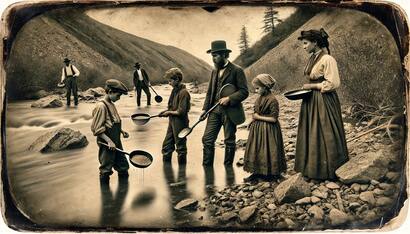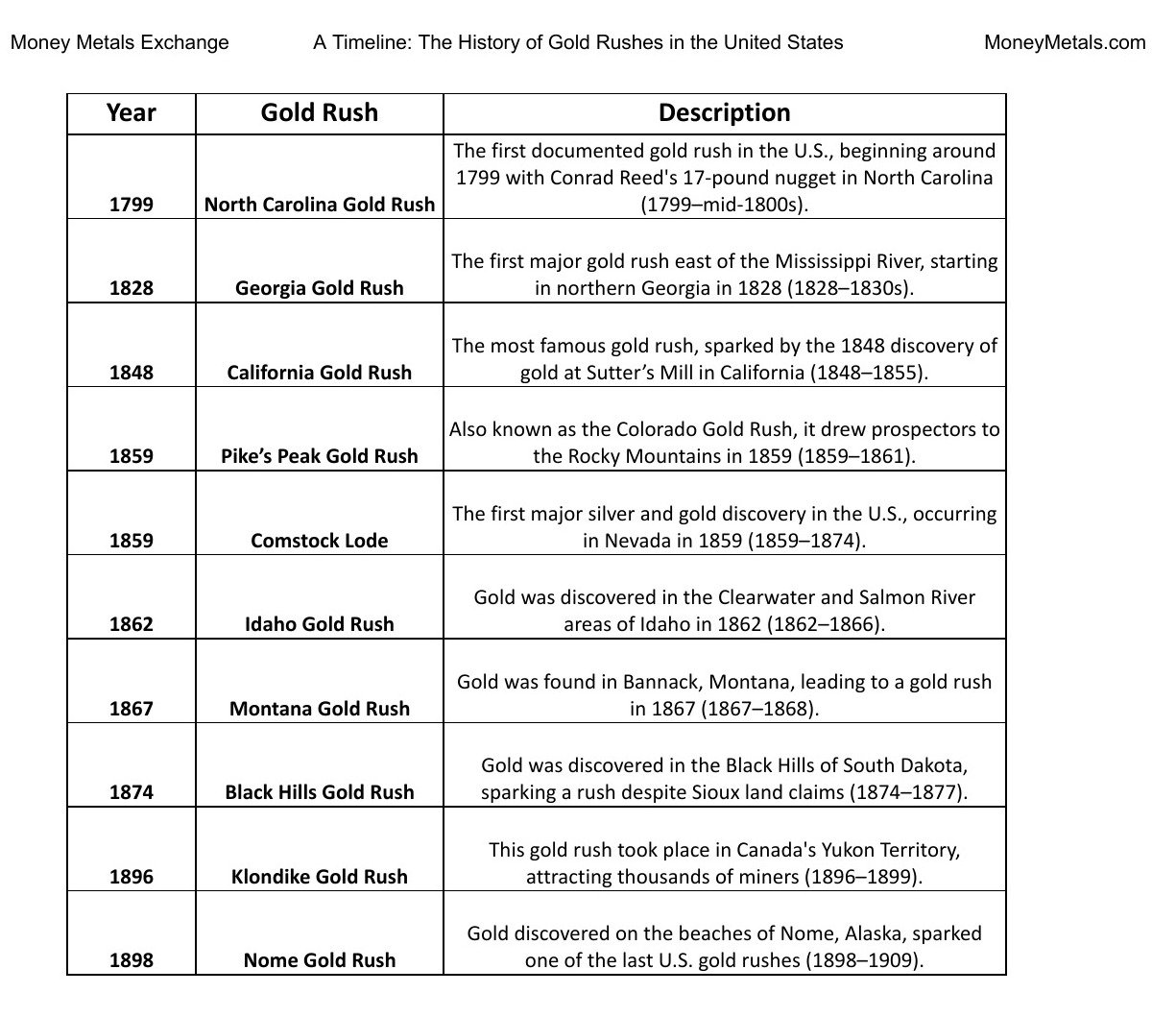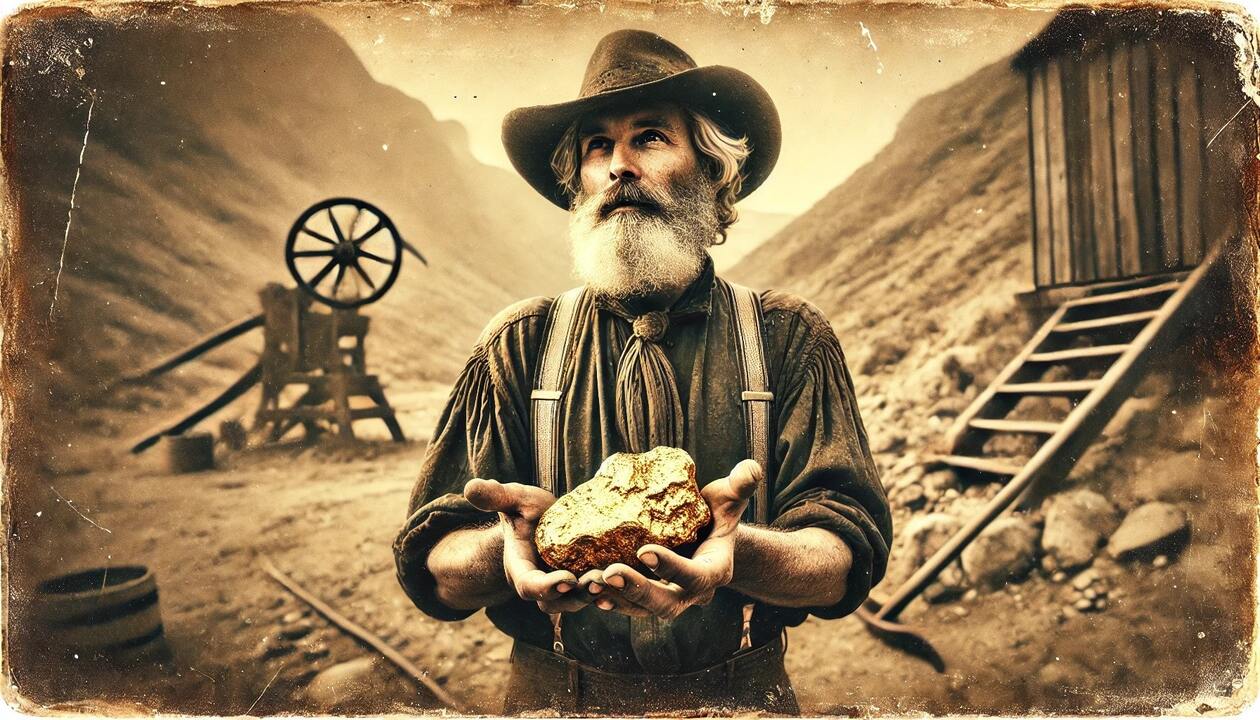(Joshua D Glawson, Money Metals News Service) The discovery of gold in the United States profoundly shaped the nation’s economic and social development, especially during the 19th century.
These gold rushes transformed regional economies, spurred massive population movements, led to the establishment of new towns, and influenced U.S. territorial expansion.
While the California Gold Rush is the most famous, other significant gold discoveries across the country played an equally vital role in the nation’s history. This article explores the key gold rushes and the famous figures that emerged from them.
North Carolina Gold Rush (1799)
The first documented gold discovery in the United States occurred in North Carolina in 1799 when Conrad Reed, a young farmer, found a 17-pound gold nugget on his family’s property in Cabarrus County.
This discovery ignited the nation’s first gold rush and led to the establishment of America’s first gold mine, the Reed Gold Mine.
Throughout the 1820s, gold mining thrived in the state, and by the mid-1830s, North Carolina was the leading gold producer in the U.S. The rush also led to the creation of the Charlotte Mint, designed to turn the mined gold into U.S. legal currency.
Famous Figures:
- Conrad Reed: His discovery of the first gold nugget in the U.S. made him a notable figure in North Carolina history, sparking America’s first gold rush.
- Joseph Bechtler: He established a private mint (the Bechtler Mint) in Rutherfordton, North Carolina in the 1830s, producing the first gold dollar coin in the U.S. and other trusted gold coins that were widely circulated in the Southeast during the Carolina Gold Rush. His mint provided a reliable local currency long before the U.S. government established official mints in the region.
Georgia Gold Rush (1828)

Following North Carolina’s example, the second major U.S. gold rush took place in Georgia. Gold was discovered near Dahlonega in 1828, attracting thousands of prospectors to the southern Appalachian region.
According to Lawrence Reed, this rush led to the creation of the Dahlonega Mint in 1838 to facilitate coin production from local gold deposits.
The Georgia Gold Rush also played a part in the displacement of the Cherokee Nation through the Trail of Tears, as white settlers encroached on Native American lands in search of gold.
Famous Figures:
- Jesse Hogan: His early discovery of gold in Georgia sparked the rush.
- Franklin Calhoun: A powerful figure during the Georgia Gold Rush, Calhoun expanded his wealth and influence through land and gold mining operations.
California Gold Rush (1848)
The most famous gold rush in U.S. history began in 1848 when James W. Marshall discovered gold at Sutter’s Mill in Coloma, California. News of the find spread rapidly, leading to a mass migration of fortune seekers, known as “forty-niners.”
According to Dr. Albert Camarillo, professor of history at Stanford University, the population of California surged as thousands of prospectors flocked to the state. The economic impact of the gold rush helped California become a state by 1850, and cities such as San Francisco grew rapidly as centers of commerce and trade.
The California Gold Rush is often considered a turning point in U.S. history due to its significant contributions to the nation’s expansion and economy.
Famous Figures:
- Samuel Brannan: California’s first millionaire, Brannan capitalized on the rush by selling supplies to miners.
- Claude Chana: A French immigrant and prospector who played a key role in the California Gold Rush. In 1848, he discovered gold along the banks of the American River in what is now Auburn, California, shortly after the famous discovery at Sutter’s Mill. Chana’s discovery helped ignite the massive influx of gold seekers to California, contributing to the rapid expansion of the region. He is often remembered as one of the first significant figures in the gold rush era, and he is the main inspiration for gold panners depicted on coins, rounds, bars, statues, and various artworks.
- John Sutter: The owner of Sutter’s Mill, Sutter played a pivotal role in the start of the rush but lost much of his wealth and land to the miners.
- Levi Strauss: Founder of Levi Strauss & Co., he made his fortune selling durable denim to miners.
- Leland Stanford: Stanford made a fortune from gold rush-related businesses and went on to found Stanford University.
Pike’s Peak Gold Rush (1859)
In 1859, gold was discovered in the Rocky Mountains near what is now Denver, Colorado, spurring a rush of nearly 100,000 prospectors known as “Fifty-Niners,” according to research conducted by Aaron Walton at Western Mining History.
This event, commonly called the Pike’s Peak Gold Rush, resulted in the rapid settlement of Colorado and the founding of Denver as a major economic hub.
Although not all prospectors struck it rich, the influx of people and resources led to the creation of the Colorado Territory, playing a crucial role in westward expansion.
Famous Figures:
- Horace Tabor: Initially a prospector, Tabor became one of the wealthiest men in Colorado, known for his success in silver mining.
- Augusta Tabor: Horace Tabor’s wife, who played a key role in their business ventures during the gold rush.
Comstock Lode (1859)
The Comstock Lode, discovered in 1859 near Virginia City, Nevada, was primarily known for its silver, but it also yielded significant amounts of gold. The discovery of this massive lode became one of the largest and most lucrative mining booms in American history, financing much of Nevada’s early development.
The wealth generated from the Comstock Lode helped fund the Union during the Civil War and contributed to Nevada’s admission as a state in 1864. The Comstock’s importance lies in its dual impact on silver and gold mining in the American West.
Famous Figures:
- Henry Comstock: The namesake of the Comstock Lode, though he did not profit significantly from the discovery.
- John Mackay: One of the “Bonanza Kings,” Mackay became a mining magnate and one of the wealthiest men in the U.S. through the Comstock Lode.
Idaho Gold Rush (1862)

In 1862, prospectors discovered gold in the remote wilderness of Idaho, specifically in the Clearwater and Salmon River regions. This discovery attracted miners to the Idaho Territory, leading to the rapid development of mining towns like Pierce and Florence.
The Idaho Gold Rush contributed significantly to the settlement of the Pacific Northwest and played a crucial role in establishing Idaho as a key gold-producing region.
Famous Figures:
- Elias Davidson Pierce: The discoverer of gold in Idaho’s Clearwater region, his find launched the rush in Idaho.
- Henry Spalding: A missionary, Spalding helped maintain relations between miners and Native American tribes during the rush.
Montana Gold Rush (1867)
Montana became another important gold-producing state following significant discoveries in Bannack and Virginia City.
The Montana Gold Rush helped populate the Montana Territory, especially after the discovery of gold in Alder Gulch in 1863, one of the richest strikes in U.S. history.
Bannack and Virginia City became major mining hubs, and thousands of miners and settlers flocked to the area, helping Montana thrive.
Famous Figures:
- Henry Plummer: A lawman-turned-outlaw, Plummer became notorious for leading a gang while serving as sheriff of Bannack.
- Granville Stuart: A successful prospector, rancher, and author, Stuart was also a key figure in Montana’s Vigilance Committee.
Black Hills Gold Rush (1874)
Gold was discovered in the Black Hills of South Dakota in 1874 during an expedition led by General George Custer.
This discovery triggered the Black Hills Gold Rush, which drew thousands of miners to the region. The town of Deadwood was established as a result of this rush, becoming synonymous with frontier mining life.
However, the gold rush also fueled conflicts with the Lakota Sioux, as the Black Hills were sacred to them and were supposed to remain in their possession under the Treaty of Fort Laramie.
Famous Figures:
- Wild Bill Hickok: A legendary figure of the Old West, Hickok moved to Deadwood during the Black Hills Gold Rush and was famously killed while playing poker.
- Calamity Jane: A famous frontierswoman, she gained renown for her adventures and association with Wild Bill Hickok.
- George Custer: While better known for his military career, Custer’s expedition discovered gold in the Black Hills, triggering the rush.
Klondike Gold Rush (1896)
Although the Klondike Gold Rush occurred in Canada’s Yukon Territory, it significantly impacted the United States, particularly Alaska. Thousands of prospectors passed through Alaska on their way to the Klondike region after gold was discovered in 1896.
The difficult conditions of the journey, along with the harsh wilderness of the Yukon, made the rush perilous, but the promise of riches enticed many.
Towns like Skagway in Alaska became crucial gateways to the goldfields. The Klondike Gold Rush helped develop Alaska as a key frontier and resource hub.
Famous Figures:
- Jack London: The famed author participated in the Klondike Gold Rush, which inspired much of his writing, including The Call of the Wild.
- Skookum Jim Mason: A member of the Tagish First Nation, Mason is credited with discovering the gold that triggered the Klondike rush.
- George Carmack: Along with Skookum Jim, Carmack played a key role in the Klondike discovery.
Nome Gold Rush (1898)
Shortly after the Klondike rush, another gold discovery occurred on the beaches of Nome, Alaska, in 1898.
According to researchers at the Smithsonian National Postal Museum, the ease of access to the beach gold led to a rapid influx of miners, and the town of Nome quickly became a bustling hub for prospectors.
The Nome Gold Rush marked the last significant gold rush in U.S. history, contributing to Alaska’s development and solidifying its reputation as a gold-rich territory.
Famous Figures:
- John Brynteson: A Swedish immigrant, Brynteson’s discovery of beach gold in Nome set off the rush.
- Wyatt Earp: The famed lawman opened the Dexter Saloon in Nome during the gold rush, adding to his colorful legacy.
Additional Figures from Lesser-Known Gold Rushes
- William Greeneberry Russell: A prospector during the early Colorado Gold Rush, Russell’s discovery in Cherry Creek set the stage for the larger Pike’s Peak rush.
- Felix Pedro: His discovery of gold near Fairbanks, Alaska, in 1902 triggered the Fairbanks Gold Rush, helping to develop the Alaska Territory.
- Levi Bootes: An entrepreneur who made his fortune during the Juneau Gold Rush, Bootes became a leading figure in Alaska’s early gold mining industry.
The Legacy of U.S. Gold Rushes

The individuals who rose to prominence during these gold rushes were as diverse as the rushes themselves. Some became wealthy entrepreneurs and political figures, while others are remembered for their colorful lives in the wild frontier.
The gold rushes in the United States did more than enrich a few lucky prospectors—they fundamentally altered the landscape of the nation. These events spurred massive migrations, fostered the development of new territories and states, and played a critical role in westward expansion.
The wealth generated by these gold rushes helped finance the growth of the American economy and contributed to its status as a global power.
Though the days of massive gold rushes have passed, the legacy of these events remains in the towns, industries, and legends they left behind, shaping the history of the United States for generations to come.
Joshua D. Glawson is Content Manager for Money Metals Exchange and is writer on such topics as politics, economics, philosophy, finance, and personal development. He has a Bachelor’s in Political Science from the University of California Irvine.

